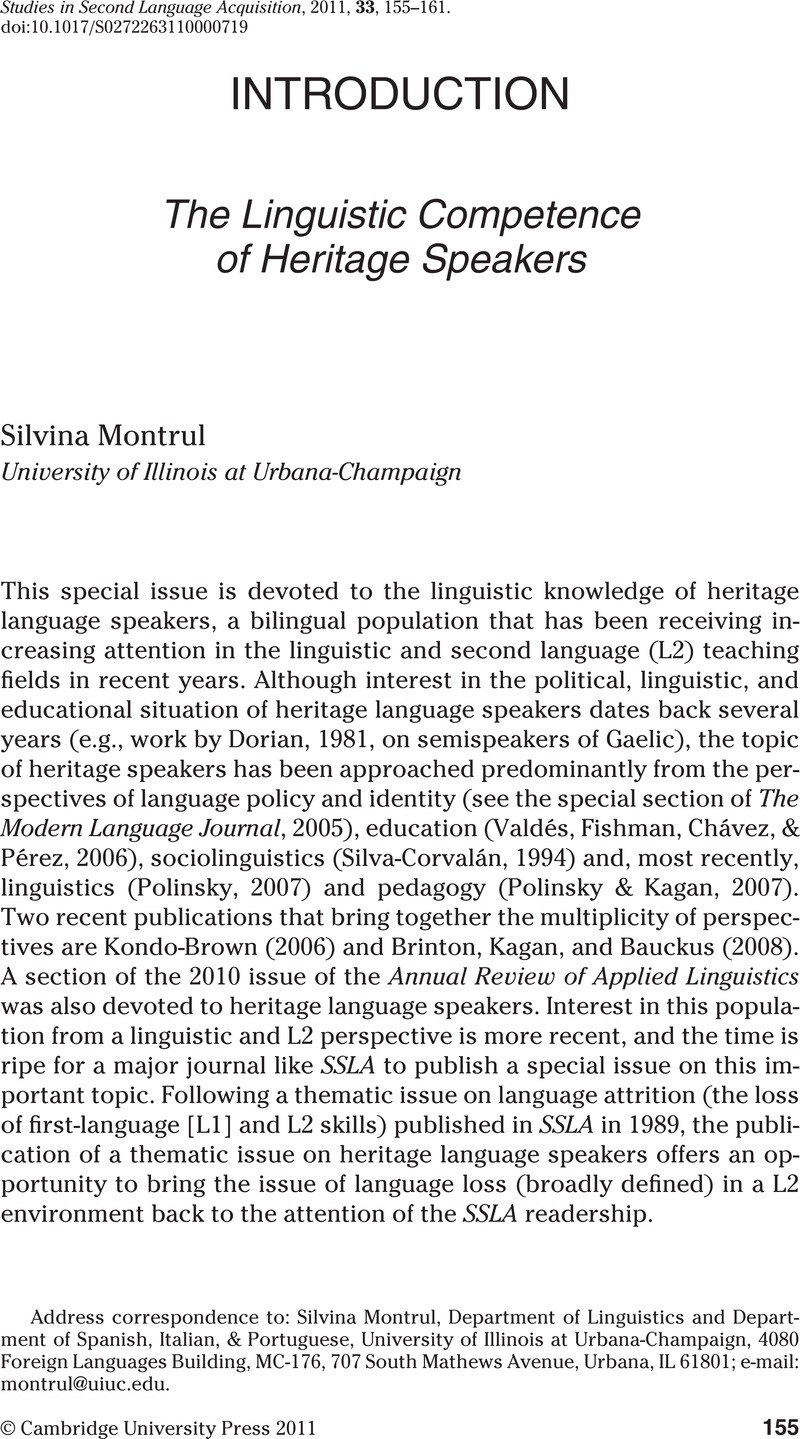Crossref Citations
This article has been cited by the following publications. This list is generated based on data provided by Crossref.
Montrul, Silvina
Bhatt, Rakesh
and
Bhatia, Archna
2012.
Erosion of case and agreement in Hindi heritage speakers.
Linguistic Approaches to Bilingualism,
Vol. 2,
Issue. 2,
p.
141.
Park, Mi Yung
and
O'Grady, William
2013.
An Interview with William O'Grady, University of Hawai'i at Manoa.
The Korean Language in America,
Vol. 18,
Issue. 1,
p.
141.
Park, Mi Yung
and
O'Grady, William
2013.
An Interview with William O'Grady, University of Hawai'i at Manoa.
The Korean Language in America,
Vol. 18,
Issue. 1,
p.
141.
Montrul, Silvina
de la Fuente, Israel
Davidson, Justin
and
Foote, Rebecca
2013.
The role of experience in the acquisition and production of diminutives and gender in Spanish: Evidence from L2 learners and heritage speakers.
Second Language Research,
Vol. 29,
Issue. 1,
p.
87.
Montrul, Silvina
and
Foote, Rebecca
2014.
Age of acquisition interactions in bilingual lexical access: A study of the weaker language of L2 learners and heritage speakers.
International Journal of Bilingualism,
Vol. 18,
Issue. 3,
p.
274.
Albirini, Abdulkafi
and
Benmamoun, Elabbas
2014.
Aspects of second-language transfer in the oral production of Egyptian and Palestinian heritage speakers.
International Journal of Bilingualism,
Vol. 18,
Issue. 3,
p.
244.
MONTRUL, SILVINA
DAVIDSON, JUSTIN
DE LA FUENTE, ISRAEL
and
FOOTE, REBECCA
2014.
Early language experience facilitates the processing of gender agreement in Spanish heritage speakers.
Bilingualism: Language and Cognition,
Vol. 17,
Issue. 1,
p.
118.
Cuza, Alejandro
and
Frank, Joshua
2015.
On the role of experience and age-related effects: Evidence from the Spanish CP.
Second Language Research,
Vol. 31,
Issue. 1,
p.
3.
Hager, Malin
and
Müller, Natascha
2015.
Ultimate attainment in bilingual first language acquisition.
Lingua,
Vol. 164,
Issue. ,
p.
289.
WU, SHU‐LING
2016.
Development of Thinking for Speaking: What Role Does Language Socialization Play?.
The Modern Language Journal,
Vol. 100,
Issue. 2,
p.
446.
Montrul, Silvina A.
2016.
Advances in Spanish as a Heritage Language.
Vol. 49,
Issue. ,
p.
99.
Burgo, Clara
2017.
Comparing advanced L2 and heritage language learners’ Spanish grammars.
Revista Española de Lingüística Aplicada/Spanish Journal of Applied Linguistics,
Vol. 30,
Issue. 1,
p.
52.
Amengual, Mark
2018.
Asymmetrical interlingual influence in the production of Spanish and English laterals as a result of competing activation in bilingual language processing.
Journal of Phonetics,
Vol. 69,
Issue. ,
p.
12.
Cuza, Alejandro
Jiao, Jian
and
López-Otero, Julio César
2018.
Does Typological Proximity Really Matter? Evidence from Mandarin and Brazilian Portuguese-Speaking Learners of Spanish.
Languages,
Vol. 3,
Issue. 2,
p.
13.
Montrul, Silvina A.
2018.
Meaning and Structure in Second Language Acquisition.
Vol. 55,
Issue. ,
p.
149.
Dabašinskienė, Ineta
and
Krivickaitė-Leišienė, Eglė
2019.
Multilingualism in the Baltic States.
p.
205.
Sagarra, Nuria
Sánchez, Liliana
and
Bel, Aurora
2019.
Processing DOM in relative clauses.
Linguistic Approaches to Bilingualism,
Vol. 9,
Issue. 1,
p.
120.
Lu, Yuan
2019.
L2 distribution of Chinese connectives: Towards a comprehensive understanding of a discourse grammar.
Second Language Research,
Vol. 35,
Issue. 4,
p.
557.
Montrul, Silvina
Bhatia, Archna
Bhatt, Rakesh
and
Puri, Vandana
2019.
Case Marking in Hindi as the Weaker Language.
Frontiers in Psychology,
Vol. 10,
Issue. ,
Polinsky, Maria
and
Scontras, Gregory
2020.
Understanding heritage languages.
Bilingualism: Language and Cognition,
Vol. 23,
Issue. 1,
p.
4.





